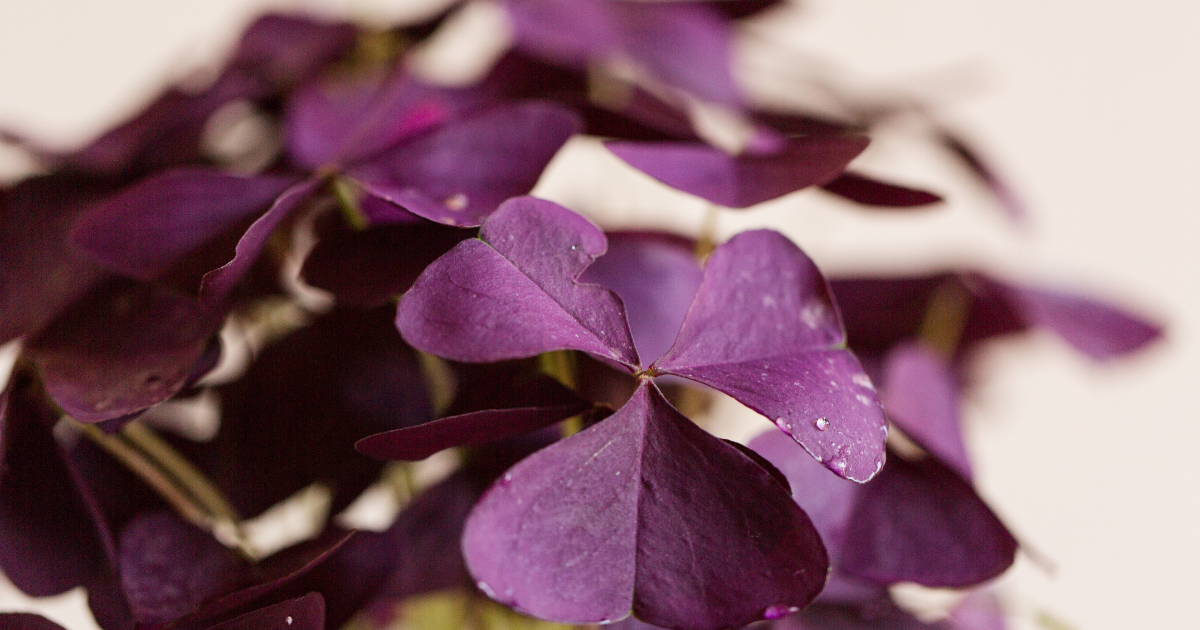Some common problems can make it hard to take care of Oxalis triangularis, which is also known as Purple Shamrock. Understanding these issues is key to maintaining a healthy plant. Here are five common Oxalis triangularis problems and how to address them:
The shamrock plant (Oxalis triangularis) is a popular houseplant known for its cheerful green, clover-like leaves. However, sometimes those bright leaves can take on an unhappy brown color. Browning leaves are never something you want to see on your prized shamrock. But don’t worry – with the right troubleshooting, you can get your Oxalis back to its vibrant self.
In this article, we’ll look at the common causes of brown leaves on shamrock plants and how to fix them
Why Are My Shamrock Leaves Turning Brown?
There are a few key reasons shamrock leaves may turn brown
-
Sunburn – Too much direct sun can scorch the delicate leaves, causing brown crispy spots and edges. Shamrocks prefer bright indirect light.
-
Underwatering – Letting the soil dry out too much between waterings can lead to browning leaves. Shamrocks like consistently moist (but not soggy) soil.
-
Overwatering – Excess moisture leads to root rot, which causes leaves to yellow and brown. Allow the top inch of soil to dry before watering.
-
Low humidity – Shamrocks thrive in average home humidity. Very dry air can cause leaf browning around the edges. Group plants together or use a pebble tray to boost humidity.
-
Cold drafts – Exposure to cold temperatures or drafts from vents/doors can damage leaves. Keep shamrocks away from drafty spots.
-
Dormancy – Some shamrocks naturally lose leaves and go dormant in winter. This causes leaves to yellow then brown before dropping. It’s normal seasonal behavior.
How to Fix and Prevent Brown Leaves
If your shamrock leaves are browning, use these tips to get it healthy again:
-
Move to a spot with bright indirect light to prevent sunscald. East or west windows are best.
-
Check soil moisture frequently and water when the top inch becomes dry. Don’t let it get bone dry or stay soggy.
-
Trim off any severely damaged leaves. Remove yellowed or rotten roots if overwatered.
-
Mist frequently or use a pebble tray to provide extra humidity around the plant.
-
Keep in a warm spot away from drafty windows/vents. Avoid temperatures below 60°F.
-
Be patient if browning is due to seasonal dormancy. New growth will resume in spring.
-
Fertilize monthly in spring and summer with a balanced houseplant fertilizer to nourish plants.
-
Monitor for pests like spider mites that can cause stippling damage. Treat any infestations promptly.
Enjoy Your Vibrant Shamrocks
With the right adjustments to lighting, watering, humidity and other care, you can get your shamrock leaves back to their bright, beautiful selves in no time. Pay close attention to your plant and troubleshoot promptly when you notice any browning. Catching issues early prevents major damage. With proper care, you’ll be rewarded with stunning shamrock plants that add lively green color indoors year-round.

Lack of Sunlight or Improper Lighting
Getting bright, indirect light is very important for Oxalis triangularis to grow and have colorful leaves. Insufficient light can lead to stunted growth, with the plant failing to reach its full potential.
The best place is one that gets some direct sunlight, especially in the morning or late afternoon when the sun’s rays aren’t as strong, followed by bright, indirect sunlight for the rest of the day. If you don’t have a lot of natural light, like in the winter or in homes with windows that don’t face the best direction, you could use grow lights to make sure your Oxalis gets the light it needs to grow.
Even though Oxalis triangularis is pretty hardy, it can still get pests. Spider mites and aphids are two of the most common ones. These pests can quickly compromise plant health, leading to weakened plants and stunted growth. Neem oil, a natural and effective pest deterrent, can be used to control these infestations.
Spraying your plant once a week with a mixture of one tablespoon of neem oil and a gallon of water can help keep pests away and keep your Oxalis healthy and bright.
Overwatering and Root Rot
Overwatering is a common issue with Oxalis triangularis, leading to soggy soil and subsequent root rot. This plant does best in soil that drains well. A mix of perlite and sand will help the soil drain and keep water from pooling at the roots. To avoid overwatering, feel the top inch of soil to see how wet it is; if it’s dry, it’s time to water.
During the plants dormant periods, typically in fall and winter, its crucial to scale back on watering. Plants need a lot less water during the dormant phase, and continuing to water regularly can make the soil too wet, which is perfect for root rot. You can also keep plants from getting too much water by using a pot with enough drainage holes and not using saucers that are full of water.
How to SAVE or REVIVE a Dying Oxalis Plant? Oxalis Triangularis Plant Care
FAQ
How to bring oxalis triangularis back to life?
How often should you water oxalis triangularis?
Does Oxalis like sun or shade?
Can you overwater Oxalis?

